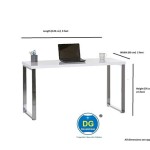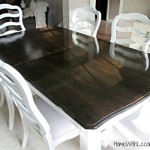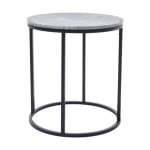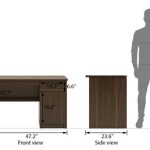Dining Room Table With Bench Seat: A Practical and Stylish Choice
The dining room table serves as a central gathering point within a home, facilitating shared meals, conversations, and memorable moments. Selecting the appropriate dining room furniture is a significant decision that requires careful consideration. A dining room table with a bench seat presents a compelling alternative to traditional chair setups, offering a blend of practicality, style, and flexibility. This article explores the attributes, benefits, and considerations associated with selecting a dining room table accompanied by a bench seat.
The integration of a bench seat into a dining room setting fundamentally alters the aesthetic and functional dynamics of the space. While individual chairs offer defined seating for each person, a bench seat promotes closer interaction and communal dining experiences. This configuration often proves advantageous in homes with children or those who frequently entertain guests, as the bench seat can accommodate varying numbers of individuals with relative ease. Furthermore, the visual impact of a bench seat introduces a sense of casual elegance and contemporary design to the overall dining room décor.
Space Efficiency and Versatility
One of the principal advantages of a dining room table with a bench seat lies in its efficient utilization of space. In comparison to chairs, benches generally occupy less physical area, particularly when pushed fully under the table. This can be especially beneficial in smaller dining rooms or open-concept living spaces where maximizing available square footage is a priority. The compact design of a bench seat allows for easier maneuvering around the table, improving the flow of traffic within the room.
The versatility of a bench seat extends beyond its space-saving attributes. A bench can serve multiple purposes, functioning not only as seating during mealtimes but also as a decorative element or a temporary surface for displaying items when not in use for dining. Certain bench designs incorporate built-in storage compartments, offering an additional organizational solution for storing placemats, napkins, or other dining-related items. This multi-functionality enhances the overall practicality of the dining room furniture.
Consider the configuration of the dining space when evaluating the suitability of a bench seat. While benches are generally well-suited for placement against a wall, providing back support and creating a more intimate seating arrangement, they can also be used on both sides of the table. In this case, ensure that sufficient space is available for individuals to comfortably enter and exit the bench seating. The dimensions of the bench should also be carefully matched to the size of the table to maintain aesthetic balance and functional harmony.
Stylistic Considerations and Design Integration
The aesthetic impact of a dining room table with a bench seat should not be underestimated. This furniture combination presents a wide range of stylistic possibilities, allowing homeowners to personalize their dining spaces according to their individual preferences. From rustic farmhouse designs to sleek modern interpretations, the versatility of bench seating allows for seamless integration into various interior design themes.
The choice of materials plays a crucial role in shaping the overall aesthetic. A wooden table paired with a matching wooden bench evokes a sense of warmth and natural charm, complementing rustic or traditional interiors. Conversely, a glass-topped table combined with a metal-framed bench imparts a contemporary and minimalist feel. Upholstered bench seats, featuring fabric or leather coverings, add a touch of luxury and comfort, enhancing the overall dining experience.
Pay attention to the details when selecting a dining room table and bench seat combination. The shape of the table, whether rectangular, square, round, or oval, influences the spatial dynamics of the room. Similarly, the style and design of the bench seat, including the presence or absence of a backrest, the leg design, and the overall silhouette, contribute to the visual appeal and perceived comfort. Coordinating the finishes and hardware of the table and bench ensures a cohesive and harmonious look.
Beyond the table and bench themselves, consider the surrounding décor and accessories. A well-chosen rug can define the dining area and add visual interest, while strategically placed lighting fixtures can illuminate the table and create a welcoming ambiance. Wall art, decorative objects, and plants can further personalize the space and enhance its overall aesthetic appeal. The goal is to create a dining room that is both functional and visually appealing, reflecting the homeowner's individual style and preferences.
Practical Aspects and Maintenance
Beyond aesthetics and space efficiency, the practical aspects of a dining room table with a bench seat warrant careful consideration. The material composition of the table and bench, as well as their construction quality, directly impacts their durability, longevity, and ease of maintenance. A solid wood table, for example, is generally more durable and resistant to wear and tear than a table made of particleboard or MDF. Similarly, a well-constructed bench seat with a sturdy frame and high-quality upholstery is more likely to withstand the rigors of daily use.
Maintenance requirements vary depending on the materials used in the table and bench. Wooden surfaces typically require regular cleaning with a damp cloth and occasional polishing to maintain their luster. Glass tabletops are easily cleaned with a glass cleaner, while metal surfaces may require occasional polishing to prevent rust or corrosion. Upholstered bench seats require regular vacuuming to remove dust and debris, and spills should be addressed promptly to prevent staining.
Consider the comfort factor when selecting a bench seat. While benches offer a unique seating experience, they may not be as ergonomically supportive as individual chairs with backrests. If comfort is a primary concern, opt for a bench seat with a slightly curved backrest or incorporate throw pillows to provide additional support. The height of the bench seat should also be appropriate for the height of the table, ensuring that diners can comfortably reach their plates and engage in conversation.
Another practical consideration is the ease of assembly and disassembly. If the table and bench are purchased unassembled, ensure that the instructions are clear and that all necessary hardware is included. If the furniture needs to be moved frequently, consider models that are relatively lightweight and easy to disassemble. Prioritizing quality construction and durable materials will ultimately contribute to the long-term value and enjoyment of the dining room table and bench seat.
In conclusion, a dining room table with a bench seat presents a versatile and stylish alternative to traditional dining arrangements. Its space-saving design, aesthetic appeal, and practical considerations make it a compelling choice for homeowners seeking to create a functional and inviting dining space. By carefully evaluating the various factors discussed in this article, individuals can make informed decisions and select a dining room table and bench seat combination that perfectly complements their lifestyle and interior design preferences.

The Secret To Using Bench Seats In Any Dining Room

26 Dining Room Sets Big And Small With Bench Seating Table Set

Dining Table Set 6 Piece Wood Kitchen With Upholstered Bench And 4 Chairs Farmhouse Style Room Solid For Persons Rustic White

Dining Table With Bench Seats Addicted 2 Decorating

Dining Table Set For 6 72 Wood Rectangular Kitchen 4 Upholstered Chairs With Bench Farmhouse Style Room And People Living Furniture Walnut Com

Estudiofurniture Millbrooke Live Edge Acacia Wood Dining Table Bench Set Temple Webster

The Beauty Of Benches Classy Dining Room Table With Bench Rustic

Extending Dining Set Aldiss Oak Furniture

Diy Farmhouse Bench Love Grows Wild

Versatile Dining Table Configurations With Bench Seating








